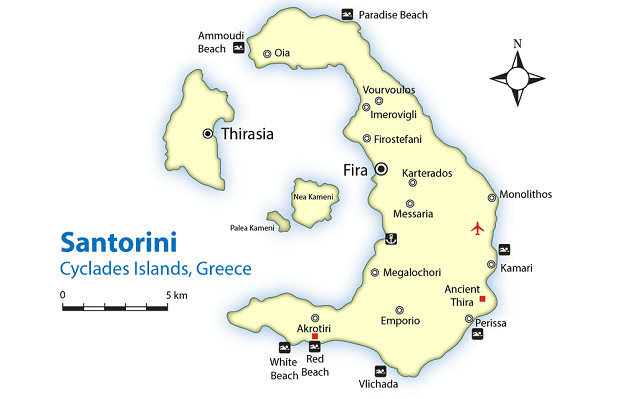
Project Description
Santorini is the supermodel of the Greek islands: multicoloured cliffs soar out of a sea-drowned caldera, topped by drifts of whitewashed buildings. With its reputation for dazzling panoramas, romantic sunsets and volcanic-sand beaches, it’s hardly surprising the island features on so many travellers’ bucket lists.
Part of the Cyclades island group, Santorini (officially known as Thira, a name that encompasses the volcanic islets within Santorini’s orbit) sits in the Aegean Sea, roughly halfway between Athens and Crete.
The island is shaped like a wonky croissant, and the neighbouring islets hint at the fact that Santorini was once circular; it was known as Strongili (the Round One). Thousands of years ago a colossal volcanic eruption caused the centre of Strongili to sink, leaving a caldera (or crater) with towering cliffs along the east side – now Santorini’s trademark landscape.
Fira, the island’s busy capital, sprawls north into villages called Firostefani (about a 15-minute walk from Fira) and Imerovigli (the highest point of the caldera edge, about a half-hour walk from Fira).
A path running through these villages is lined with upmarket hotels, restaurant terraces and endless photo opportunities.
These three conjoined settlements draw most visitors, together with the stunning and quite exclusive village of Oia in Santorini’s north. There’s a growing number of hotels in the island’s south, offering caldera views to the north and northeast. Akrotiri’s views come cheaper than Oia’s, but it’s a fair way from the action of Fira.
Santorini’s east coast resorts such as Kamari and Perissa have a more traditional (and more affordable) island-holiday appeal: sunlounger-filled beaches, water sports, bars and taverna-lined promenades. The east coast’s beaches are lined with black sand; on the south coast, there’s a string of beaches famed for their multicoloured sand – dramatic Red Beach is a traveller favourite.
The island’s interior is dotted with vineyards and traditional villages that let you see beyond the tourist hustle. Make a stop in Pyrgos for great eats and a wander through charming backstreets.
When to go
Peak travel time is July and August, when prices soar and hotels, viewpoints and beaches are packed with tourists. The shoulder-season months of April, May, early June, late September and October are good times to visit – things are marginally quieter at the caldera edge, and considerably quieter on the east coast (where accommodation bargains are plentiful).
Don’t discount a winter break, when crowds are scarce (and prices low) while the scenery is still breathtaking. Santorini is working on positioning itself as a year-round destination.

